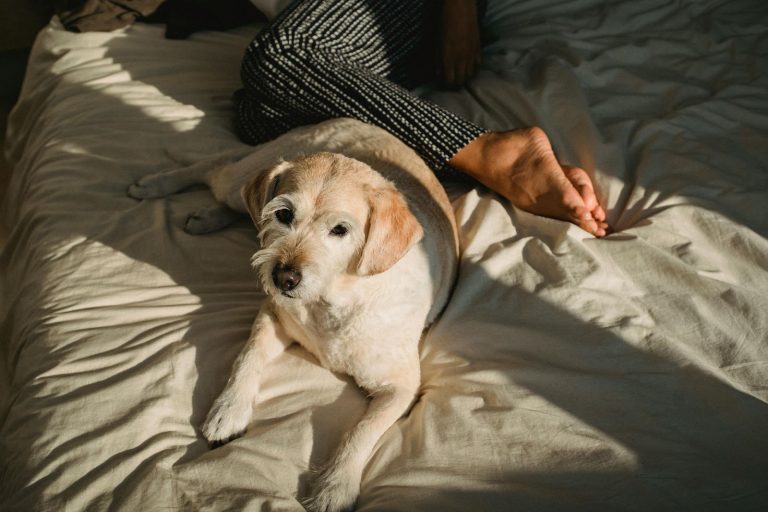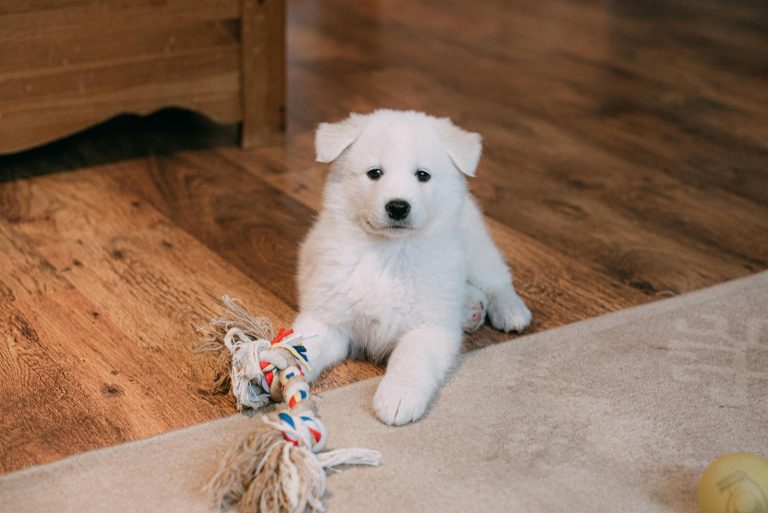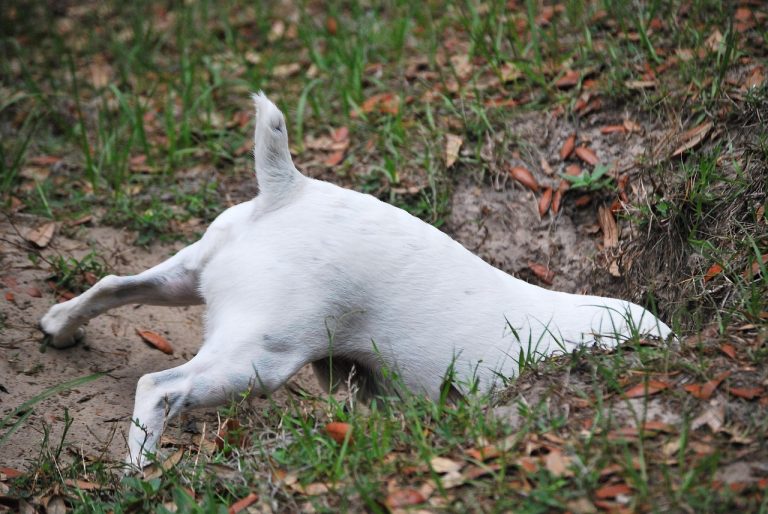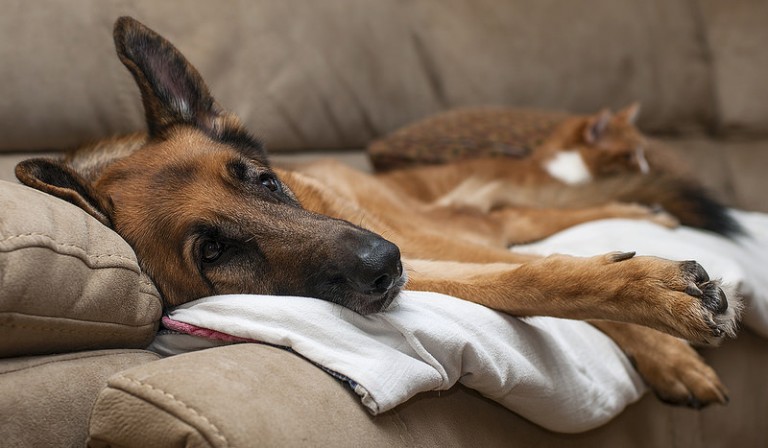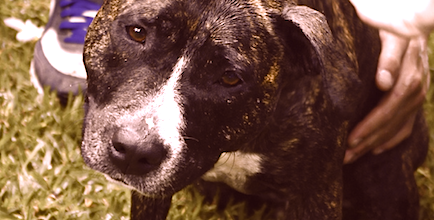How to Teach a Puppy to Lie Down on Command
Knowing how to teach “down” will become one of the most useful tools in your training arsenal. Here are some step-by-step instructions.
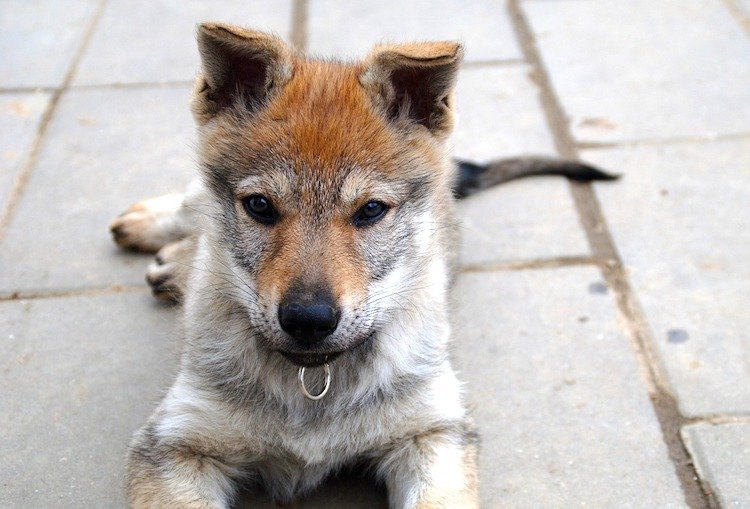
Yesterday I went out to dinner with my extended family to celebrate a special occasion.
We sat outside eating, chatting and listening to music and took up a large portion of the patio. At the end of the meal, a 75-pound dog emerged from underneath our table of almost 20 people. I had completely forgotten the German Shepherd was even there.
He had been lying still and quiet under the table for over an hour.
That dog is my sister’s service dog, Kal.
His ability to lie down quietly in frequently tight spaces allows her to bring him with her on airplanes, in the car, to work, to restaurants and stores, and to several other important places.
If he couldn’t lie down quietly out of the way, it wouldn’t matter how well he was trained to detect and alert — he wouldn’t be able to serve her as a service dog because he wouldn’t be able to go everywhere with her.
“Down” is a fantastic command to teach your dog. Not only is it useful by itself, but it can also be used to teach other behaviors, such as:
- Calmness: Many dogs struggle with anxiety, aggression, destructiveness, nipping and generally being busy. Teaching the down command can give you a way to manage those behaviors.
- Respect: Teaching your puppy “down” at a young age can increase respect without requiring you to be harsh or confrontational.
- Direction: In addition to other directional commands — such as “sit,” “out” and “stand” — “down” lets you communicate to your dog where they should be and what they should be doing. This can make life with your dog a lot easier and less stressful for both them and you.

Don’t leave your pet’s safety to chance
Sign up for Petful recall alerts today.

Teaching Your Puppy to Lie Down on Command
In this 3-part expert guide on how to teach a puppy to lie down on command, we’ll cover:
- How to teach “down”
- What to do when your puppy won’t lie down
- How to improve your down command

Part 1: How to Teach “Down”
There are several ways to teach the down command.
With puppies, you want to make the training fun, so that they will learn to enjoy training in general and will be more focused during training sessions.
Here are some step-by-step instructions on how to teach a puppy to lie down on command:
- Find something your puppy loves and will follow when you move it. If your puppy enjoys food, then kibble or treats will be the easiest training tool.
- Hide the treats in a zippered baggie in your pocket or a treat pouch behind your back. Go to a calm location and call your puppy over to you.
- If your puppy knows the sit command, have them sit. If they have not yet learned this basic command, then lure them into the sit position by touching a treat to their nose and then slowly raising the treat toward the back of their head, moving it along the bridge of their nose a couple of inches above them. Moving the treat should cause them to look up. When they can no longer see the treat above them, they should sit because they want to see it again. If your puppy tends to back up when you do this exercise, practice in a corner with their back against the wall.
- Practice having your puppy sit until they quickly sit once you show them the treat or say, “Sit.” If you would like to teach your pup the sit command at this point, then command “Sit” right before you start moving the treat. Praise them and give a treat as soon as their bottom touches the floor.
- Once your puppy is sitting, place a treat against their nose. Slowly move the treat toward the floor then away from your puppy, along the floor in front of them. Tell them, “Down” while you are moving the treat.
- If your puppy stands up while you are luring them into the down position with the treat, lure them back into the sit position and try luring them into the down position again — but this time try moving the treat even slower.
- As soon as your puppy’s chest touches the floor so that they are in the down position, praise them enthusiastically and give them the treat.
- If your puppy is still struggling to lie down after several repetitions of moving the treat, touch the treat to your puppy’s nose and lower the treat to the floor slowly — but this time, move the treat toward your puppy, between their front paws underneath them. Place a hand above your puppy’s lower back if they tend to stand up when you move the treat.
- When your puppy’s chest touches the floor, immediately praise them and give them the treat.
- Practice “down” with the treats until your puppy lies down when they see the treat or hear the command — before you move the treat.
- When your puppy will lie down on their own while the treat is not moving, remove the treat from your hand but pretend you are still holding it. Command “Down” and when your puppy obeys, praise them and feed them a treat from your other hand.
- If your puppy is struggling to lie down at this point, move your empty hand toward the floor as if you are luring with a treat while saying, “Down.” Praise them and give a treat from your other hand when your puppy lies down.
- Practice the down command with only your empty hand as a hand signal part of the time, and with only the verbal “Down” command without the hand signal part of the time, instead of giving both together every time.
- After you give the hand signal or the verbal command by itself, wait about 7 seconds to see if your puppy will do the command. If they do not lie down, give them a hint and say, “Down” or show them the hand signal.
- Practice with only the command or hand signal until your puppy can respond to both the hand signal and the verbal command when each is given by itself.
- Reward your puppy when their down was better than it was before, or every 3–5 repetitions. As they improve, decrease the number of treats over time so that they are always surprised when rewarded with a treat.
- Use life rewards to maintain your pup’s training. Practice telling your puppy to lie down before you feed them, play with them, let them outside or do something else in their routine that they enjoy. Change when you ask them to lie down and how long you have them stay in position to keep their minds sharp and their down command current.

Part 2: What to Do When Your Puppy Won’t Lie Down
Once your puppy has learned what “Down” means and can do the command in calm locations, there will be times when they will not obey your down command.
What should you do when your puppy won’t listen?
A lack of obedience is often due to:
- A lack of understanding
- An inability to obey
- Major distractions
These 3 things must be addressed to gain a consistent Down.
A Lack of Understanding
Imagine that you are in a foreign country, in line to purchase food.
A man starts motioning toward you and speaking to you in another language. Unfamiliar with the language and feeling a bit uncomfortable, you ignore the man. He becomes more insistent and even a bit angry.
You feel flustered and try to make it clear that you can’t understand him. Finally, he motions toward the ground, and you realize that you are standing on his backpack strap. Embarrassed, you quickly grab your food and walk away.
It’s easy to assume your puppy understands what you want them to do — but if you haven’t spent the time teaching them what words and hand signals mean, they likely do not. This is why you first need to teach the down command, step by step.
Most dogs do not generalize well. Just because your puppy understands how to lie down in your home, facing you, without any distractions around, doesn’t mean they understand that “Down” also means to lie down when your back is to them and another dog is running by at the park.
So practice teaching your puppy to lie down in a variety of locations, at varying distances and around different types of distractions. The more variety your pup experiences during this practice, the better they will get at generalizing the command and lying down under different circumstances.
Inability to Obey
What would you have done if your kindergarten teacher sent you home with an assignment to write a 1,000-word paper with research citations at the age of 5?
Your parents likely would have thought your teacher was crazy, and there would be no way you could have completed that assignment on your own.
Puppies develop skills by practicing them. Lying down on command is a skill your puppy learns how to do at a kindergarten level first — that’s why we call it puppy kindergarten.
As they practice that skill — for longer durations, around gradually harder distractions and at greater distances from you — they improve. Before you know it, your pup will be lying down under a restaurant patio table quietly for an hour, just like my sister’s dog Kal.
Major Distractions
Motivation is a powerful thing. If you have ever watched dogs in obedience competitions and seen their near-perfect obedience despite the hundreds of people and other dogs in the building, you understand what I mean.
Your puppy needs to be motivated to obey your command in addition to understanding it and having the skills to obey it. Reward-based training is popular for this reason.
At first, look for something that your puppy loves, such as food, and use that thing as a reward during training. As your puppy improves, you can phase out its use and instead have your puppy work for things that they enjoy throughout their day.
For example, before you feed your pup dinner, tell them to sit. Before you throw their favorite ball, command them to lie down. Incorporate training into their day-to-day life to keep them motivated.
You will inevitably run across something your puppy loves more than treats, toys, walks and pets. Because of this, your dog also needs to learn that they must obey even when they don’t want to do so.
Wait for the Down
Set up training scenarios where you can control the training outcome.
If your puppy ignores your down command even though they have demonstrated in the past that they are able to obey, and you are confident that they heard you, then keep their leash tight enough that they can’t wander off to explore.
Now wait until they lie down before you let them do anything else. Your goal is to make disobedience boring.
Expect this to take up to 30 minutes the first time you do this. Be calm but persistent.
When they do finally lie down, praise them and tell them, “OK!”
Then let them go investigate the thing they were distracted by if it is safe for them to do so.
Leash Pressure
For the persistent pup who disobeys your down command, gently press 2 fingers on either side of their tailbone while pulling up slightly on their leash. They should go into the sit position.
Then loop the leash underneath your foot and back up to your hand, like a pulley. Hold the leash tight enough so that your puppy must lower their neck a bit, but they are not forced to lie down.
Now, wait.
The goal is to make disobedience uncomfortable without hurting your pup or forcing them to completely lie down — so that they will choose to lie down in response to the discomfort of their disobedience.
Once your puppy lies down, praise them and give slack in the leash, making the down position a comfortable place to be.
Repeat the training until your puppy lies down when told to without leash pressure. When they go down willingly without leash pressure, praise and reward with a treat or life reward.
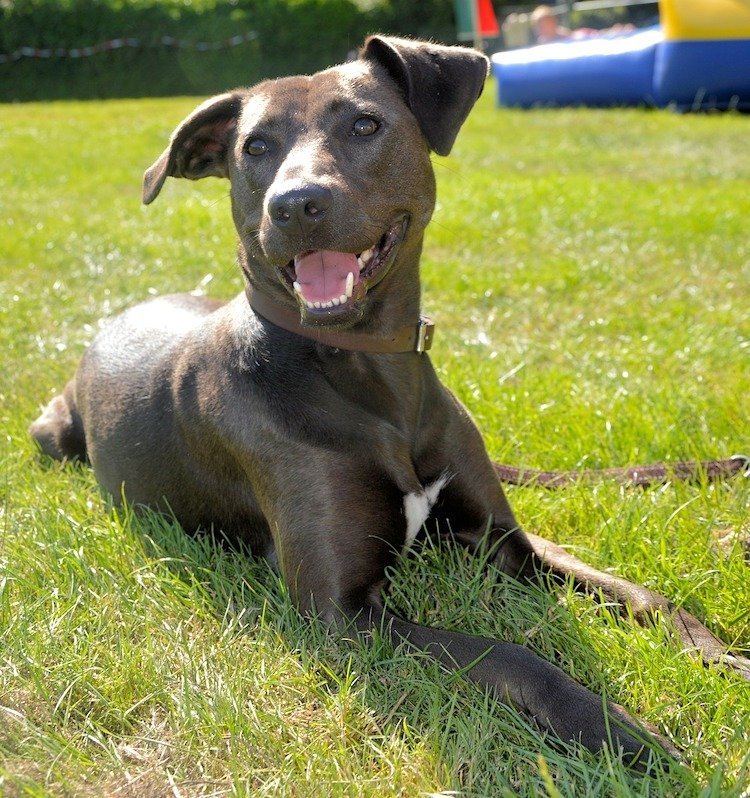
Part 3: How to Improve Your Down Command
Once your puppy knows how to lie down on command, there are so many useful and fun things you can do with that training. Teaching your puppy to lie down is only the beginning of what you can use the down command for.
Automatic Down
One useful thing you can teach your pup is to lie down in certain situations automatically.
When you take your puppy on walks, to parks, to the pet store and other locations, stand or sit still for several minutes. When the dog lies down on their own, have treats hidden in your pockets and calmly place one between your pup’s front paws while they are in the down position.
If your puppy never lies down on their own, tell them to lie down after you have been stopped for a while, then place the treat between their paws. After you have done this at least a dozen times, stop telling them “Down” and wait to see if they will offer it on their own, in hopes of getting a treat.
If you reward your puppy regularly for lying down when you sit on a bench, stop to talk to someone or read labels on items in the pet store, they will begin to settle down on their own and be calmer when you take them places.
Down-Stay
Once your puppy has learned “down,” you can work on adding a stay command.
You can also teach your puppy to automatically stay while in the down position — that is, if you are willing to always enforce staying down until you give a release command.
There are several ways to practice the stay command:
Distance Down-Stay
- Tell your dog “Down” and put your hand toward them with your palm facing out like a stop sign and say, “Stay.”
- Slowly back away. If your dog tries to get up, quickly return to them, tell them “Uh-uh” and have them return to the down position. Do not reward them when they lie back down since they broke their stay.
- Repeat backing a few feet away. If your dog stays put, calmly praise them, return to them and place a treat on the floor between their paws. Do not release them from down every time you reward because you don’t want them to think that being praised or rewarded means they can get up. If they jump up when you return to them, have them lie back down again unless you released them to get up.
- Practice backing up and returning to your dog until you can walk farther away or have them hold the command for longer — gradually increasing the length of the stay as they improve.
- When you are ready for them to get up, tell them “OK!” or “Free!”
Long Down-Stay
- Tell your dog “Down” while you are sitting down doing something such as reading, watching TV or working on a computer.
- Slip their leash under your foot. Keep the leash tight enough to prevent them from standing up if they try to get up without being released, but loose enough for it to be comfortable and relaxed while they are lying down.
- Say, “Stay.”
- Periodically reward your pup every couple of minutes for staying down if they do not try to get up. Reward frequently at first and less frequently as they improve.
- Work on this command for a few minutes at a time at first. As your puppy improves, gradually increase that amount of time until your pup can lie quietly for 1–2 hours.
- When your puppy can lie quietly for at least 1 hour without being given any treats during that hour, then remove the leash if you are somewhere where it is safe to do so. Practice without a leash, returning your pup to the down position if they get up.
Not every dog “gets” down right away. The video below provides a few alternate training methods:

Final Thoughts on How to Teach a Puppy to Lie Down on Command
“Down” is an important command that every dog should be taught. Teaching it will make life with your pup calmer, easier and safer.
It all begins with teaching your puppy what the command actually means, then practicing around distractions, for longer periods of time and from farther away.

